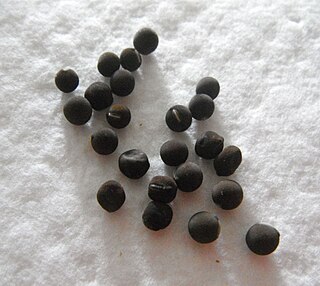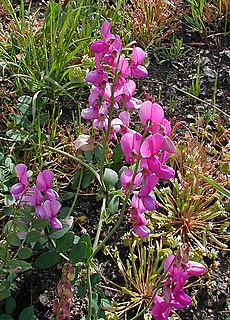Grass pea is a common name for several plants, and may refer to:
Grass pea is a common name for several plants, and may refer to:

Lathyrus is a genus of flowering plants in the legume family Fabaceae, and contains approximately 160 species. Commonly known as peavines or vetchlings, they are native to temperate areas, with a breakdown of 52 species in Europe, 30 species in North America, 78 in Asia, 24 in tropical East Africa, and 24 in temperate South America. There are annual and perennial species which may be climbing or bushy. This genus has numerous sections, including Orobus, which was once a separate genus.
Beach pea is a common name for several plants and may refer to:
Earthnut is a common name for several unrelated plants which produce a subterranean edible seed, fruit or root

The sweet pea, Lathyrus odoratus, is a flowering plant in the genus Lathyrus in the family Fabaceae (legumes), native to Sicily, southern Italy and the Aegean Islands.
Yellow pea is a common name for several plants, and may refer to:
Yellow vetch is a common name for several plants and may refer to:
Bitter vetch is a common name for several plants and may refer to:
Everlasting pea may refer to three perennial plants of the genus Lathyrus:
L. pratensis may refer to:

Lathyrus littoralis is a species of wild pea known by the common name silky beach pea. It is native to the coastline of western North America from British Columbia to California. It is a resident of beaches and dunes.
Lathyrus jepsonii is a species of wild pea known by the common names delta tule pea and Jepson's pea. It is endemic to California, where it grows in a number of habitat types, including forest and estuary.

Lathyrus palustris is a species of wild pea known by the common name marsh pea. It is native to Europe, Asia, and North America. It is a perennial herb with leaves made up of oval-shaped or oblong leaflets a few centimeters long. It has branched, coiled tendrils. The plant bears an inflorescence of two to eight pinkish purple pea flowers each up to two centimeters wide. The fruit is a dehiscent legume pod.

Lathyrus splendens is a species of wild pea known by the common names pride of California and Campo pea. It is native to Baja California and its range extends into San Diego County, California, where it grows in the chaparral. This is a climbing perennial pea vine with coiling tendrils. Its leaves are each made up of 6 to 8 linear to oval-shaped leaflets a few centimeters long and wavy-margined stipules. The plant produces showy inflorescences of up to 6 bright to deep red flowers each about 3 centimeters wide. The fruit is a hairless dehiscent legume pod.
Lathyrus sulphureus is a species of wild pea known by the common names snub pea and sulphur pea.

Lathyrus vestitus is a species of wild pea known by the common name Pacific pea. It is native to western North America, where it is mostly found in the forests, woodlands, and chaparral of California. The ranges of some subspecies extend into Oregon and Baja California. This is a perennial pea vine which varies in appearance across subspecies. Leaves are made up of several leaflets of various shapes up to 4 or 5 centimeters long. The leaves usually bear coiling tendrils and the stipules may be large or small. The inflorescence is a showy array of up to 15 pea flowers, sometimes densely packed together, and usually some shade of light to medium purple or white.
Spring vetch is a common name for several plants and may refer to:

Lathyrus rigidus is a species of wild pea known by the common name stiff pea. It is native to the Modoc Plateau and surrounding areas in the western United States from northeastern California to Idaho. It is a plant of the sagebrush scrub and other habitat in the region. This is a perennial herb forming a clump of short, erect stems. The leaves are made up of several pairs of leaflets 1 to 3 centimeters long each. The inflorescence is a dense raceme of 2 to 5 white or pink pea flowers each roughly 2 centimeters long. The fruit is a hairless legume pod.
L. palustris may refer to:
Sand pea is a common name for several plants and may refer to: